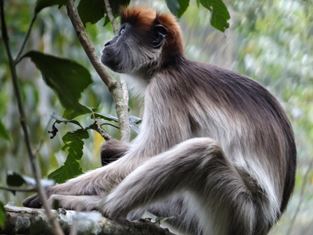Genetic analysis finds Ugandan whipworm parasite has three distinct groups
14 January 2015
A gastrointestinal worm that infects primates and humans in Western Uganda and thought to be one species has been found to be three distinct genetic groups.
Although whipworms have been known for a long time, little attention has been paid to the transmission of the parasite between primates and humans until now. The whipworm species Trichuris trichiura is known to inhabit both non-human primates and humans.
However, research by Ria Ghai, a doctoral student at McGill University, and published in PLoS Neglected Tropical Diseases, suggests that there is one strain of whipworms found only in humans, another strain that is only found in either black-and-white or red colobus monkeys, and a final strain found in both humans and primates.
About 600 million people around the world live with whipworms. Most are children in the developing world, whose physical and mental development is stunted by these gastrointestinal parasites. The whipworms affect their ability to learn and therefore have a long-term impact on the social and economic situations of some of the world's poorest people.
Ghai's research was conducted in the rainforest of Kibale National Park in southwestern Uganda, which has one of the largest concentrations of primates in the world. These include endangered species such as the red colobus monkey, the eastern chimpanzee, and the rare l'hoest's monkey as well as more common species, like baboons.

An endangered Red Colobus monkey in forest near
Kibale, Uganda
In all, there are 13 different species of primates within the park. But the park is an island of forest within one of the most densely populated agricultural regions in East Africa, with a population of 300-600 people per square km. And there is increasing human pressure on limited land and growing interaction between the two groups.
"The park has been a protected space since 1993, but for a very long time people have been going into the forest to gather wood to burn and banana leaves and grasses to weave with, as well as to hunt bush meat, and it's hard to change habits when people are in such need," says Ghai.
"The monkeys also come out of the park to raid the fields for maize and sweet potatoes. So in a place where there is little running water to wash either food or hands and where people walk barefoot wherever they go, it is not surprising that there is an exchange of fecal matter between humans and primates that has led to the transmission of whipworms."
"What this shows us is that we have been underestimating biodiversity," says co-author Prof. Colin Chapman, from McGill's Department of Anthropology and School of the Environment who has been working in the area for many years. "There are far more species of parasites around than we had expected, and we hope this new information will be useful both for conservationists and for people working in health policy."
Reference
Ghai RR et al. Hidden Population Structure and Cross-species Transmission of Whipworms (Trichuris sp.) in Humans and Non-human Primates in Uganda. PLOS Neglected Tropical Diseases. October 23, 2014. DOI: 10.1371/journal.pntd.0003256. Open acess. www.plosntds.org/article/info%3Adoi%2F10.1371%2Fjournal.pntd.0003256